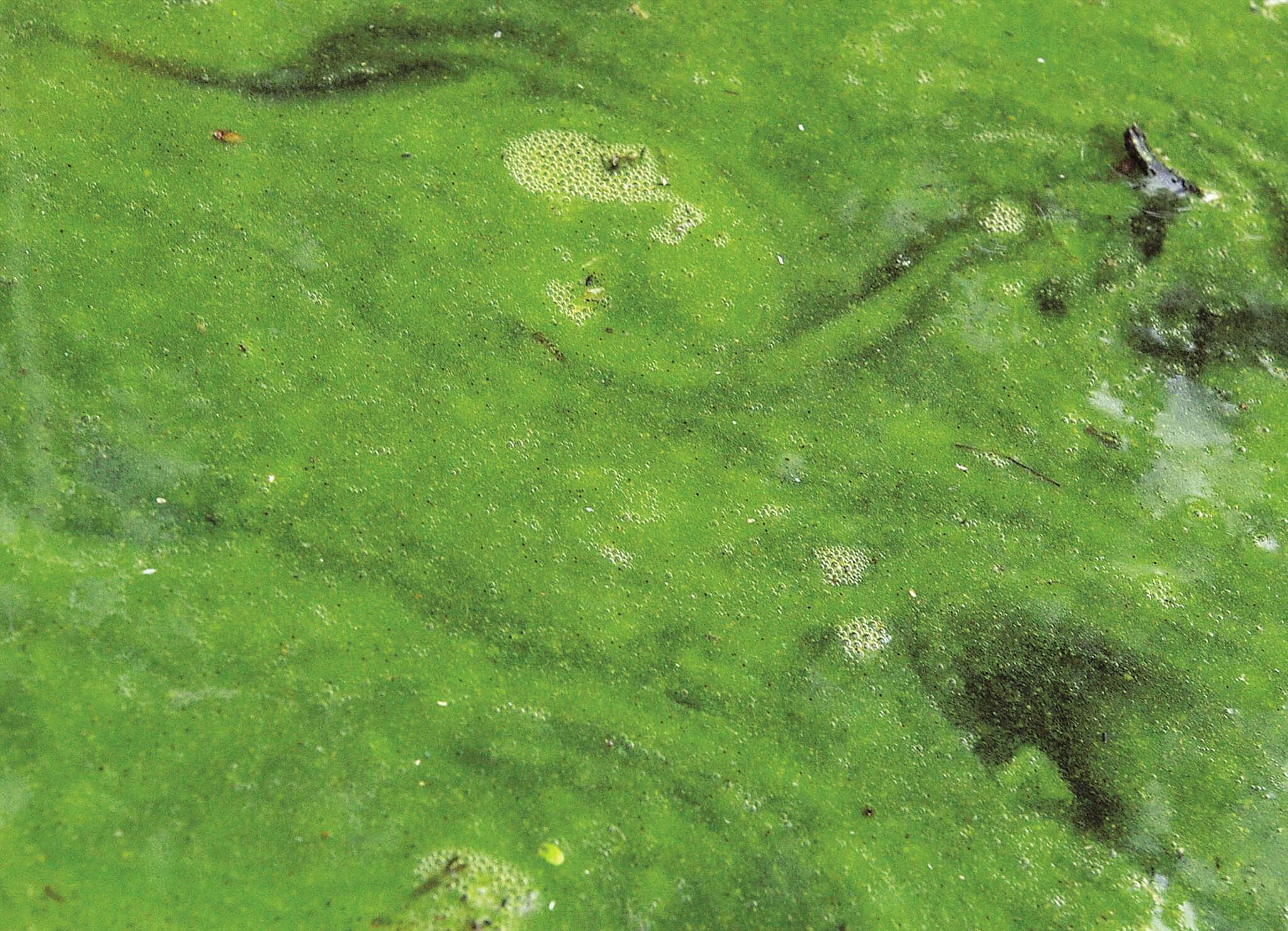News Article
Is blue dye the best solution for blue green algae?

Want to read more articles like these?
IN recent years, Lake Eildon has been impacted by blue green algae during the summer months, impacting activities conducted by both tourists and locals.
The ABC has recently reported on Lake Nhill, where blue dye has been added to reduce blue green algae blooms. Lake Nhill has been closed many times in the past due to such outbreaks, and the locals have found that the dye works better than other algae solutions.
Goulburn Murray Water (GMW) was asked whether they are considering trialling blue dye in any of their water catchments, including Lake Eildon.
GMW Water Quality Coordinator Bianca Atley responded, “At present, there are no suitable options for treating blue-green algae in large bodies of water.
“Water authorities that provide town and drinking water are sometimes able to add chemicals to water supplies to treat blue-green algae. However, these methods are not transferable for storages such as the ones GMW manages for various reasons.
“Some chemicals used to treat blue-green algae are toxic to aquatic life and recreation users. Most chemicals also need to be manually injected, which would be logistically challenging at larger storages.
“When there is a rain event, a lot of different nutrients flow into water storages that could also compromise the effectiveness of any chemicals that have been used.”
Many factors can influence the growth of blue-green algae including weather, water temperature and nutrient levels.
These and other more complex factors operate in combination, and no one factor can be pinpointed as a cause of high levels of algae.
While a solution such as dying the water may therefore be effective in one situation, it may be ineffective in another.
If a blue-green algae warning is issued, GMW does not have the option of trucking in water from an unaffected alternate source due to the large quantities of water GMW supplies and its large area of operation. Instead, GMW looks to isolate the high levels of blue-green algae to the storage it has been detected in.
If possible, GMW will lower the level at which water is released from the storage, so that the blue-green algae do not spread. This is because the algae often accumulate at the surface, lowering the offtake level can therefore minimise the chance of transferring the algae downstream. GMW’s ability to do this depends on the infrastructure at the storage.
GMW always samples downstream of its storages in order to determine if the blue-green algae has been successfully isolated.
More detail on blue-green algae along with current blue-green algae warnings can be found on the GMW website at g-mwater.com.au/news/bga
People can also phone GMW’s blue-green algae hotline on 5826 3785 anytime.
DEECA were also contacted for comment on whether blue dye might provide a viable solution in farm dams. They provided the following advice.
Prevention principles
There are measures that can be taken to minimise algal blooms include: minimising nutrient level of water flowing into the dam; manipulating the concentration or cycling of nutrients within the dam water. Encourage diluting and flushing during wetter months; minimising sunlight load on the dam; minimise the temperature of dam water; encourage gentle mixing of dam water to avoid stratification of water into discrete temperature layers; prevent stock physically disturbing dam sides and sediments, or defecating and urinating in the water.
Planning and management practices
Keep a comprehensive vegetative cover on the catchment area. Maintain a vigorous cover of plants of reasonable height (ideally above 5mm). Avoid acidification, soil structural damage or fertility, which will reduce vegetative growth. Prevent the baring of soil as the result of overgrazing or preferential grazing. Minimise the time cultivated soils remain bare and time operations to enable rapid revegetation.
Control soil erosion
Repair and reclaim eroding areas. Keep soil disturbance operations (roading, building sites, drains) to a minimum. Use judicious design, construction and maintenance of tracks and roads. Avoid cultivation of steep slopes.
Use strategic fertiliser programs
Match fertiliser application soil and plant needs. Apply fertiliser at times of strongest plant growth. Do not spread close to drainage lines or dams.
Locate and manage intensive animal operations
Minimise the production and concentration of animal wastes recycle wastes (extensively) onto pastures or appropriate crops. Use storage ponds of adequate capacity to hold liquid wastes before recycling. Keep intensive operations away from streams and drainage lines.
Drainage line management
Keep drainage lines well vegetated. Dense grassy swards are suitable for drainage lines in the upper part of catchments but tree based vegetation is needed around streams and waterways. Employ properly constructed drainage line crossings for stock and vehicle movement. Restrict stock access to beds and banks of streams. Fence as appropriate. Provide off-stream watering points. Do not allow roads, tracks or intensively cropped areas to drain directly into streamside areas or natural drainage lines.
Dam design and construction
Use large deep dams to give lower water temperatures and reduce the intensity of temperature stratification of the water. Locate and size dams to encourage the regular dilution and flushing of stored water from catchment flows. Locate dam to minimise sunlight load where possible. Construct water entry path into excavation of the dam such that it does not cause excessive turbulence and scour.
Dam management
Employ buffer or filter zones of thick vegetation immediately upstream of the dam to minimise entry of sediment and nutrients. Fence dam and reticulate water to troughs. Minimise erosion caused by wave action, but encourage a reasonable amount of wind action over the surface of the water to mix surface layers of water with lower layers. Do not allow surrounding vegetation to block too much of the wind. Occasionally de-sludge dam to avoid excessive build up of sediments and organic material. Minimise disturbance of bottom sediments by……..
Continue subscribing to our newspapers for the complete story here.
...continue reading the full article by subscribing to our weekly, monthly or annual subscription here.
If you see a photo in the paper of your child, grandchild, partner, or friend we can supply you with a copy to put on your wall as long as Alexandra Newspapers took the photo (we cannot provide a copy of a photo that was taken by a third party).
Alexandra Newspapers is proud to distribute our two primary publications through newsagents, supermarkets, petrol stations and many other outlets across the Murrindindi Shire and beyond.
Alexandra Newspapers offers display and classified advertisements as well the ability to promote your business. Both the Alexandra Standard and the Yea Chronicle offer classified ads for: Births, Deaths, Marriages, Situations Vacant, For Sale, Garage Sale, In Memoriam, Happy Birthday, Anniversary, Public Notice, Meetings, Automotive, Car/Caravan/Motorbikes/Boats. For Rent/Lease, and Wanted.
Alexandra Newspapers can provide commercial printing of plans, posters, business stationery, invoice and receipt books, self-inking stamps and more. Reach out to us for any commercial printing jobs here.
Grab a copy of the weekly newspaper or reach out to us here for subscribing an offline newspaper copy.
Like, comment and share the article on your facebook page.
Want to read more articles like these?

Services
Newspapers
© 2020 - 2025. ALEXANDRA NEWSPAPERS. All rights reserved.
Privacy Policy | Terms of Use | Sitemap
Website built with ❤ by Regional Business Toolkit


